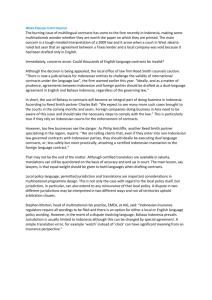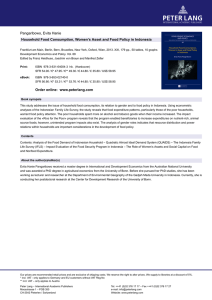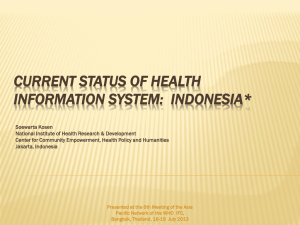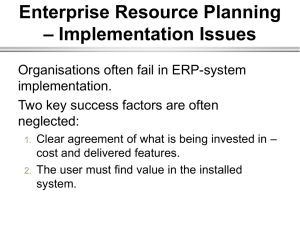6. Archipelago@Crossroads 6. Archipelago@Crossroads
advertisement
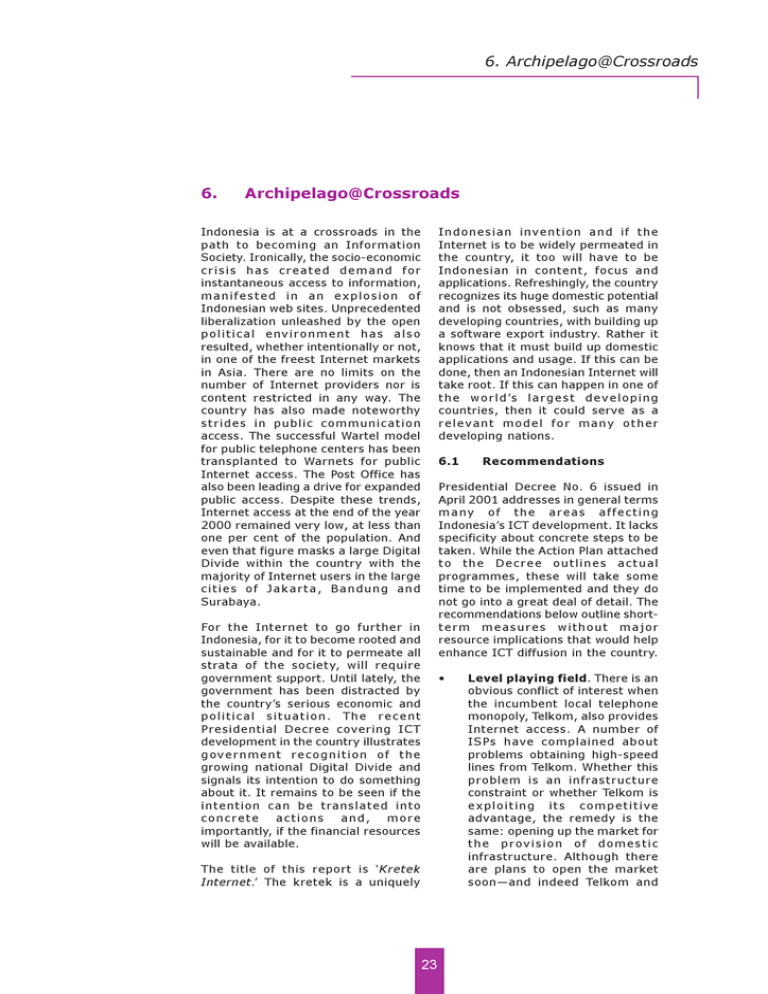
6. Archipelago@Crossroads
6.
Archipelago@Crossroads
Indonesia is at a crossroads in the
path to becoming an Information
Society. Ironically, the socio-economic
crisis has created demand for
instantaneous access to information,
manifested in an explosion of
Indonesian web sites. Unprecedented
liberalization unleashed by the open
p o l i t i c a l e nv i r o n m e n t h a s a l s o
resulted, whether intentionally or not,
in one of the freest Internet markets
in Asia. There are no limits on the
number of Internet providers nor is
content restricted in any way. The
country has also made noteworthy
strides in public communication
access. The successful Wartel model
for public telephone centers has been
transplanted to Warnets for public
Internet access. The Post Office has
also been leading a drive for expanded
public access. Despite these trends,
Internet access at the end of the year
2000 remained very low, at less than
one per cent of the population. And
even that figure masks a large Digital
Divide within the country with the
majority of Internet users in the large
cities of Jakarta, Bandung and
Surabaya.
Indonesian invention and if the
Internet is to be widely permeated in
the country, it too will have to be
Indonesian in content, focus and
applications. Refreshingly, the country
recognizes its huge domestic potential
and is not obsessed, such as many
developing countries, with building up
a software export industry. Rather it
knows that it must build up domestic
applications and usage. If this can be
done, then an Indonesian Internet will
take root. If this can happen in one of
t h e w o r l d s l a r g e s t d e v e l o p i n g
countries, then it could serve as a
r e l e va n t m o d e l f o r m a n y o t h e r
developing nations.
6.1
Recommendations
Presidential Decree No. 6 issued in
April 2001 addresses in general terms
m a ny o f t h e a r e a s a f f e c t i n g
Indonesias ICT development. It lacks
specificity about concrete steps to be
taken. While the Action Plan attached
to the Decree outlines actual
programmes, these will take some
time to be implemented and they do
not go into a great deal of detail. The
recommendations below outline shortterm measures without major
resource implications that would help
enhance ICT diffusion in the country.
For the Internet to go further in
Indonesia, for it to become rooted and
sustainable and for it to permeate all
strata of the society, will require
government support. Until lately, the
government has been distracted by
the countrys serious economic and
political situation. The recent
Presidential Decree covering ICT
development in the country illustrates
g ov e r n m e n t r e c o g n i t i o n o f t h e
growing national Digital Divide and
signals its intention to do something
about it. It remains to be seen if the
intention can be translated into
concrete actions and, more
importantly, if the financial resources
will be available.
The title of this report is Kretek
Internet. The kretek is a uniquely
23
Level playing field. There is an
obvious conflict of interest when
the incumbent local telephone
monopoly, Telkom, also provides
Internet access. A number of
ISPs have complained about
problems obtaining high-speed
lines from Telkom. Whether this
problem is an infrastructure
constraint or whether Telkom is
e x p l o i t i n g i t s c o m p e t i t i ve
advantage, the remedy is the
same: opening up the market for
t h e p r ov i s i o n o f d o m e s t i c
infrastructure. Although there
are plans to open the market
soonand indeed Telkom and
Indonesia Internet Case Study
Indosat will already be competing
in some areasit will take a while
before
true
competition
materializes. In the meantime, it
might be useful to allow ISPs to
provide their own infrastructure
when needed. Alternatively, the
regulator could review the terms
and conditions of Telkoms leased
line offerings to ISPs to try to
ensure a level playing field.
create
and
disseminate
information, particularly for
illiterate users.
Another area that could drive
Internet awareness and usage is
the development of a few killer
applications. These could apply
to government-related services
that are widely used. One
example would be the local
identity card that is required of
every adult and typically time
consuming to obtain. Allowing
citizens to complete the
application for the identity card
online would save time, make the
process more transparent and
just might be the sort of thing
t h a t d r i ve s p e o p l e t o t h e
Internet. Arrangements could be
made with Wartels to assist users
in completing the form, take and
upload digital photos and
distribute
the
completed
identification card when it is
ready.
Local applications. T h e
majority of Indonesian Internet
use constitutes e-mail or
information searching. There is
not generally a lack of local
content as there are a growing
number of web sites in the
Indonesian language. What is
lacking are local applications that
would generate more demand for
Internet access and really help
it take root in the country. There
are a number of areas where
application development could
yield gains. One is the
development of applications for
rural communities. This includes
t h e c r e a t i o n o f a g r i c u l t u ra l
portals that provide pricing
information, weather forecasts,
transport schedules, farming
techniques and other related
information. In addition to
Indonesian, these applications
s h o u l d b e d e ve l o p e d i n
languages that are used in the
rural areas. Programmers should
work closely with the local
community to find out what kind
of information they need. This
could be in the form of a sort of
Indonesian Digital Scout
programme where ICT-skilled
youth go to rural areas to work
with local communities to
develop applications and train
local users. While traditional web
access via a PC will be important,
o t h e r i n n ovativ e w ay s o f
disseminating information may
be appropriate. This can include
relaying information downloaded
from the web via photocopies or
b r o a d c a s t i n g ove r a l o c a l
loudspeaker system or local
radio. Another technique is to use
audio and video streaming to
P a ra l l e l t o t h i s e f f o r t , t h e
g ov e r n m e n t m i g h t wa n t t o
designate a number of flagship
applications and provide support
f o r t h e l o c a l Re s e a r c h a n d
Development community to build
them. This could include help for
special software centers.
The development of dot-com
companies should also be
facilitated. This could include tax
breaks and other incentives for
c o n t e n t c r e a t o r s . D o t- c o m
incubators could also be
explored, perhaps as part of the
d e v e l o p m e n t o f s o f t wa r e
development parks. Partnerships
with Singapore, Brunei and
M a l ay s i a w h e r e t h e M a l a y
language is used and closely
related to Indonesian, could be
explored as these countries could
provide expertise and resources.
24
Flexible pricing. Indonesian
Internet prices are relatively high
compared to other South East
Asian
nations.
This
is
e x a s p e ra t e d b y t h e l o w e r
incomes in Indonesia, which
6. Archipelago@Crossroads
makes access expensive. The
price of 30 hours of Internet
access in Indonesia is more than
twice the average monthly per
capita expenditure. If Internet
use is to increase, then the price
of access must be reduced. One
component of the dial-up
Internet charge is the telephone
t a r i f f. A c c o r d i n g t o o n e
Indonesian Internet expert, if
telephone tariffs were lowered,
the number of Internet
subscribers could reach 20
million in the country. 26 It is
recommended that telephone
usage charges for dial-up
Internet access be waived or
reduced. Another idea is to share
the telephone usage charge
between ISPs and Telkom. This
would allow ISPs to provide free
Internet access. The example of
L i n k N e t s f r e e I S P p l a n i s
pertinent here. In less than one
year, LinkNet acquired almost
200000 subscribers, making it
the largest ISP in the country.
However this model provides
u n s u s t a i n a b l e s i n c e Te l ko m
would not share the telephone
charge.
access. The potential for
expanding Internet access
through public locations such as
schools or Warnets is immense.
According to Postel, the potential
size of the Internet market in
Indonesia is over 60 million users
( i . e ., 3 0 p e r c e n t o f t h e
population), some 30 times
higher than it is today. Most of
these new users would access
the Internet from schools and
Warnets if the facilities were
available. As a first step, the
same agreement that allows
Wartels to purchase wholesale
airtime from Telkom should be
extended to the Warnets. This
will allow them to reduce their
costs and make service even
more
affordable.
Other
incentives such as tax breaks
should be provided to Warnets
t h a t l o c a t e i n r u ra l o r
u n d e r s e r ve d
areas.
The
government should also deploy
some of its education budget for
the purchase of ICT equipment
and Internet access. In addition,
it should devise a universal
access policy that includes
discounted Internet access to
schools.
Universal access. The majority
of Indonesians cannot afford
F o r e i g n i n v e s t m e n t. T h e
individual Internet access.
government will be hard pressed
Additionally, roughly 90 per cent
to both provide adequate social
of homes do not have telephone
services as well as provide the
lines let alone
computers. Thus if
Figure 6.1: Indonesia's Potential Net Market
the Internet is to
become
widespread in the
c o u n t r y, i t w i l l
High
have to be through
School
Potential Internet
public locations.
18%
Offices
Users in
Indeed, statistics
16%
Indonesia
indicate that the
Total: 61 million:
majority of IndoReligious
29% of 2000
nesians already
schools
population
access
the
11%
Warnet
Internet
from
50%
public locations
such as Warnets.
Universities
This has happened
5%
despite
few
government policies for supporting
Source: POSTEL, 2000.
public Internet
25
Indonesia Internet Case Study
needed expenditures to promote
ICT development. One important
source of funding could be
international investors that are
attracted by Indonesias large
market source and potential.
There is legitimate concern that
opening markets too quickly
might affect weaker domestic
companies.
H o w e ve r
the
g overnment must resist the
temptation to champion local
companies over foreign ones in
order to attract badly needed
investment. It must explore ways
to attract investment while
ensuring widespread access.
26
about a number of important
indicators such as users, user
profiles or web sites visited are
based on irregular media reports
that are typically limited in
c overage or of questionable
m e t h o d o l o g y. T h u s f a r, t h e
limited number of operators in
the telecommunication sector
has facilitated the aggregation of
national statistics. However this
will change as new operators
enter the market. It is
recommended that BPS and
Postel jointly develop an online
ICT statistical system. This would
include collection of key market
indicators
from
telecommunication operators
and ISPs and aggregation at a
country and provincial level. It
is also recommended that BPS
include a number of questions
about ICT equipment ownership
in household surveys. It is further
recommended
that
the
government sponsor ongoing
surveys to obtain ICT-related
information about key sectors of
the economy such as the value
of e-commerce, ICT human
resource
situation
and
requirements, ICT usage in the
educational sector, etc.
Market research. There is a
serious shortage of ICT market
information for Indonesia. This
ranges from reliable surveys on
the number of Internet users to
the current ICT workforce. The
national statistical agency (BPS)
does not collect ICT indicators
nor does the government agency
responsible
for
telecommunications, Postel.
Although some market research
firms occasionally compile ICTrelated data for the country,
these are scarce or costly to
obtain. Therefore information
ISPs Show Promising Future, As Subscriber Numbers Increase. Detikworld. 19 April 2001.
http://www.detikworld.com/inet/2001/04/19/2001419-180116.shtml.
26
Annexes
Annex 1: State of the Internet in Indonesia
The Mosaic Group <www.agsd.com/
gdi97/gdi97.html>, has developed a
framework for characterizing the state
of the Internet in a nation. They
consider six dimensions, each of which
has five ordinal values ranging from
zero (non-existent) to four (highly
developed). The dimensions are as
follow:
pervasiveness : a measure
based on users per capita and the
degree to which non-technicians
are using the Internet.
g e o g r a p h i c d i s p e r s i o n: a
measure of the concentration of
the Internet within a nation, from
none or a single city to
nationwide availability.
connectivity infrastructure: a
measure based on international
a n d i n t ra n a t i o n a l b a c k b o n e
bandwidth, exchange points, and
last-mile access methods.
organizational infrastructure:
a measure based on the state of
the ISP industry and market
conditions.
s o p h i s t i c a t i o n o f u s e: a
measure characterizing usage
from conventional to highly
sophisticated and driving
innovation.
I n d o n e s i a n va l u e s f o r t h e s e
dimensions are in Figure 1.1.
Pervasiveness is rated at level 3,
Common. At December 2000, there
were approximately 400000 Internet
subscribers in the country translating
to an estimated two million users, or
0.95 per cent of the population.
sector absorption: a measure
of the degree of utilization of the
Internet in the education,
commercial, health care and
public sectors.
Figure 1.1: State of the Internet in Indonesia
Dimension
Value
Pervasiveness
3
Geographic Dispersion
3
Sectoral Absorption
2.5
Organizational Infrastructure
3.5
TOTAL
4
3
2
1
0
Sophistication
1.5
Connectivity Infrastructure
Sophistication of Use
Pervasiveness
Organizational
Dispersion
Absorption
2
Connectivity
15.5
Note: The higher the value, the better. 0 = lowest, 4 = highest.
Source: ITU adapted from Mosaic Group methodology.
27
Indonesia Internet Case Study
levels of international connectivity.
The main domestic operator has a
nationwide fibre/microwave/satellite
backbone that operates at various
speeds. There is a domestic traffic
exchange with two connection points.
In addition, the larger ISPs also peer
amongst themselves. High-speed local
access is growing with leased line
being the main access methods. ADSL
is being tested and access via cable
modem access has several thousand
users.
High-speed
satellite
connections are also being used.
Geographic Dispersion is rated at
level 3, at Highly dispersed. Internet
access is available from all provincial
capitals. Nationwide dial-up access is
available via a four-digit telephone
number at a standard tariff of Rp 160
per minute (0.92 US cents per hour).1
The main constraint to nationwide
connectivity is local access since most
households do not have a telephone,
let alone a personal computer.
Sector Absorption is rated at level 1.5,
between Rare and Moderate. This
ranking is a function of the type of
connectivity in education, government,
health care and business. There is a
good degree of connectivity at the
university level. Connectivity at the
primary and secondary level is less
profuse. Less than 2000 out of 13000
secondary schools are connected and
very few primary schools have an
Internet connection. A number of
government ministries are on the web
although there is no central portal.
Few provincial governments have a
web site. The Ministry of Health has
its own web site and an Intranet with
about 80 users. Around 20 of some
400 government hospitals have a web
page. Large businesses have web sites
but few Small and Medium Enterprises
(SMEs) do.
The Organizational Infrastructure
is at level 3.5, between Competitive
a n d Robust. There were around
60 operational ISPs at the end of
2000. There is no limit on the number
of licenses that can be granted to
p r ovide Internet access service
(around 150 have been issued). There
is an ISP association that runs a public
traffic exchange. However the market
is dominated by a few ISPs including
the main telecom operators. Most ISPs
are not allowed to provide their own
national infrastructure and must lease
from telecom operators. There have
been allegations from some ISPs that
the largest telecom operator has an
a d va n t a g e s i n c e i t d i c t a t e s t h e
availability and conditions of leased
lines.
The Connectivity Infrastructure is
at level 2.5, between Expanded and
Broad. International connectivity of
t h e t h r e e l a r g e s t I S P s i s ov e r
146 Mbps; other ISPs have varying
1
Sophistication of Use is at level 2,
Conventional. The most popular
applications among most users appear
to be e-mail and information retrieval.
Using a conversion rate of Rp 10 785 to US$ 1 at 20 April 2001.
28
Annexes
Annex 2: Telecommunication statistics
INDONESIA
National currency: Rupiah
Area: 1919443 km2
8QLW
<HDU(QGLQJ
'(02*5$3+<(&2120<
3RSXO DWL RQ
[
¶
+RXVHKRO GV
[
*URVV'RPHVWL F3URGXFW
[
*URVV)L[HG&DSLWDO)RUPDWLRQ
[
$YHUDJHDQQXDOH[FKDQJHUDWHSHU
&RQVXPHUSULFHLQGH[
7HOHFRPHTXL SPHQWH[SRUWV86
[
7HOHFRPHTXL SPHQWLPSRUWV86
[
7(/(3+21(1(7:25.
0DLQWHOHSKRQHOLQHV
[
¶
¶
0DLQWHOHSKRQHOLQHVSHU
5HVLGHQWLDOPDLQOLQHVSHUKRPHV
'LJL WDOPDLQOLQHV
3XEOLFSD\SKRQHV
[
02%,/(6(59,&(6
&HOOXODUPRELOHWHOHSKRQHVXEVFUL EHUV
[
¶
'LJLWDOFHOOXODUVXEVFUL EHUV
[
²
&HOOXODUVXEVFULEHUVSHU
7(/(3+21(75$)),&
,QWHUQDWL RQDORXWJRL QJPLQXWHV
[
,QWHUQDWL RQDOLQFRPLQJPLQXWHV
[
7RWDOLQWHUQDWLRQDO PLQXWHV
[
1DWL RQDOSXOVHV
[
¶
¶
67$))
)XOOWLPHWHO HFRPPXQLFDWL RQVWDII
48$/,7<2)6(59,&(
)DXOWVSHUPDLQOLQHVSHU\HDU
7$5,))6
5HVLGHQWLDOWHO HSKRQHFRQQHFWLRQ
%XVLQHVVWHOHSKRQHFRQQHFWL RQ
5HVLGHQWLDOWHO HSKRQHPRQWKO\IHH
%XVLQHVVWHOHSKRQHPRQWKO\IHH
PLQXWHO RFDO WHOHSKRQHFDOOSHDN
&HOOXODUFRQQHFWLRQ
¶
&HOOXODUPRQWKO\
¶
PLQXWHO RFDO FHOOXODUFDOOSHDN
5(9(18(
7RWDOWHOHFRPVHUYLFHV
[
7HOHSKRQHVHUYLFH
[
0RELOHFRPPXQLFDWLRQ
[
¶
¶
&$3,7$/(;3(1',785(
¶
$QQXDOWHOHFRPLQYHVWPHQW
[
%52$'&$67,1*
7HOHYLVL RQVHWV
[
+RPHVDWHOOLWHDQWHQQDV
[
¶
,1)250$7,217(&+12/2*<
3HUVRQDO FRPSXWHUV
[
,QWHUQHWKRVWV
[
²
,QWHUQHWXVHUV
[
¶
(1) Source: UN (1991, 2000); 1995-1999: BPS. 1999 excluding East Timor. (2) 1995:1999 BPS. Other years: ITU estimate. 1999
excluding East Timor. (3) Source: IMF. (4) UN. From 1998, unofficial estimates, source US Department of Commerce. (5) Excluding
payphones and mobile cellular phones. (6) Telkom and Indosat. (7) Yearly estimate from monthly data. (8) Maximum tariffs not
including taxes. (9) Telkom and Indosat. (10) ITU estimates. (11) Source: Computer Industry Almanac, ITU estimates. (12) Source:
Internet Software Consortium. (13) APJII.
29
Indonesia Internet Case Study
Annex 3: Schedule of meetings
'DWH
7LPH
3HUVRQ
0RQGD\$SULO
0U3DQGML&KHVLQ$3-,,
0U*DQGXQJ0XUGDQL37,QGRVDW
0U$JXV$EGLOODK377HONRP
0RQGD\$SULO
0U2WWR0XUGLDQWR3RV,QGRQHVLD:$6$17$5$1(7
7XHVGD\0D\
'U,PURQ%XONLQ%$33(1$6
'U=DLQDO+DVLEXDQ8QLYHUVLWDV,QGRQHVLD
.$',7%,17(/'$1,1)250$7,.$
6XU\DWLQ6HWLDZDQ.D'LY5,67,377(/.20
7XHVGD\0D\
0U$L]LUPDQ'MXVDQ7.7,
0DV:LJUDQWRUR0DVWHO
0U5XGLDQWDUD([FHOFRPLQGR0DVWHO
0U$ULIXGLQ0DVWHO
6GU.HSDOD%LUR3XVDW6WDWLVWLN%36
6UL<DQWR$3:,
5XGL5XVGLDK$:$5,
0U:LOOLDP<LQ/\PDQ
0U:HQGUD1DWDVHQGMDMD/\PDQ
:HGQHVGD\0D\
:HGQHVGD\0D\
'DQL6XPDUVRQR&%1
0U0XMLRQR.DSXVGDWLQ'HSGDJUL
0U0DUVHWLDZDQ'HSGDJUL
0U6XGXQJ1DLQJJRODQ'HS.HV
0U+DUL3XUZDQWR'HS.HV
0V/ROO\$PDOLD,37(.1(7
:HGQHVGD\0D\
0U,3XWX6XU\DZLUDZDQ',7-(1,/0($
0U,QVDQ3UDNDVD37(',
0U6DIDU,GKDP376XFRILQGR
7KXUVGD\0D\
0U6XQDU\D5XVODQ'LUHFWRUDWH*HQHUDO5DGLR79)LOP
0U+DQGRNR7DQXDGML.DEHO9LVLRQ
0U+LOOPDQ6XODLPDQ,QGRQHVLDQ&KDPEHURI&RPPHUFH
0U*XQDGL3RVWHO
)ULGD\0D\
0U1RRU,]D3RVWHO
0U$]KDU+DV\LP3RVWHO
30
Annexes
Annex 4: Abbreviations and Acronyms
ADSL
Asymmetrical Digital Subscriber Line
APJII
Indonesian ISP Association
AWARI
Indonesian Internet Kiosk Association
B2C
Business to Consumer
BAPPENAS
National Development Planning Agency
BPS
National Statistical Office
GoI
Government of Indonesia
GPRS
General Packet Radio Services
ICT
Information and Communication Technology
IMF
International Monetary Fund
ISP
Internet Service Provider
IT
Information Technology
KSO
Kerjasama Operasi (Joint operating scheme)
LoI
Letter of Intent
MITI
Ministry of Industry and Trade
PC
Personal Computer
PCS
Personal Communication Systems
PoP
Point of Presence
Rp
Indonesian Rupiah, the national currency. At June 30 2001, the rate was
Rp 11400 to US$ 1. Note that the Rupiah has been subject to wide
variation and US$ figures in this report should be treated with caution.
SME
Small and Medium Enterprises
TKTI
Indonesia Coordinating Team on ICT
UT
Universitas Terbuka
31
Indonesia Internet Case Study
Annex 5: Useful web sites
*RYHUQPHQW
3RVWHO7HOHFRPUHJXODWRU
ZZZSRVWHOJRLG
%$33(1$61DWLRQDO3ODQQLQJ$JHQF\
ZZZEDSSHQDVJRLG
%36&HQWUDO%XUHDXRI6WDWLVWLFV
ZZZESVJRLG
0DLQWHOHFRPRSHUDWRUV
,QGRVDW
ZZZLQGRVDWFRP
6DWHOLQGR
ZZZVDWHOLQGRFRLG
7HONRP
ZZZWHONRPFRLG
/HDGLQJ,63V
&%1
ZZZFEQQHWLG
,QGRVDW1HW
ZZZLQGRVDWQHWLG
/LQN1HW
ZZZOLQNQHWLG
7HONRP1HW
ZZZWHONRPQHWLG
,&7LQGXVWU\DVVRFLDWLRQV
$3-,,,QGRQHVLDQ,63$VVRFLDWLRQ
ZZZDSMLLRULG
0DVWHO,QGRQHVLDQ,QIRFRPP6RFLHW\
ZZZPDVWHORULG
0HGLD
.DEHOYLVLRQ
ZZZNDEHOYLVLRQFRP
'HWLNRP
ZZZGHWLNFRP
.RPSDV
ZZZNRPSDVFRLG
7HPSR
ZZZWHPSRFRLG
7KH-DNDUWD3RVW
ZZZWKHMDNDUWDSRVWFRP
32
Annexes
Annex 6: Bibliography
APJII, others. Indonesia Cyber Industry & Market. 2001. Jakarta.
PT Indosat. Annual Report. Various years.
National Statistical Office. Statistical Yearbook. 1999.
PT Telkom. Annual Report. Various years.
USAID. Indonesia: ICT Assessment.
33


